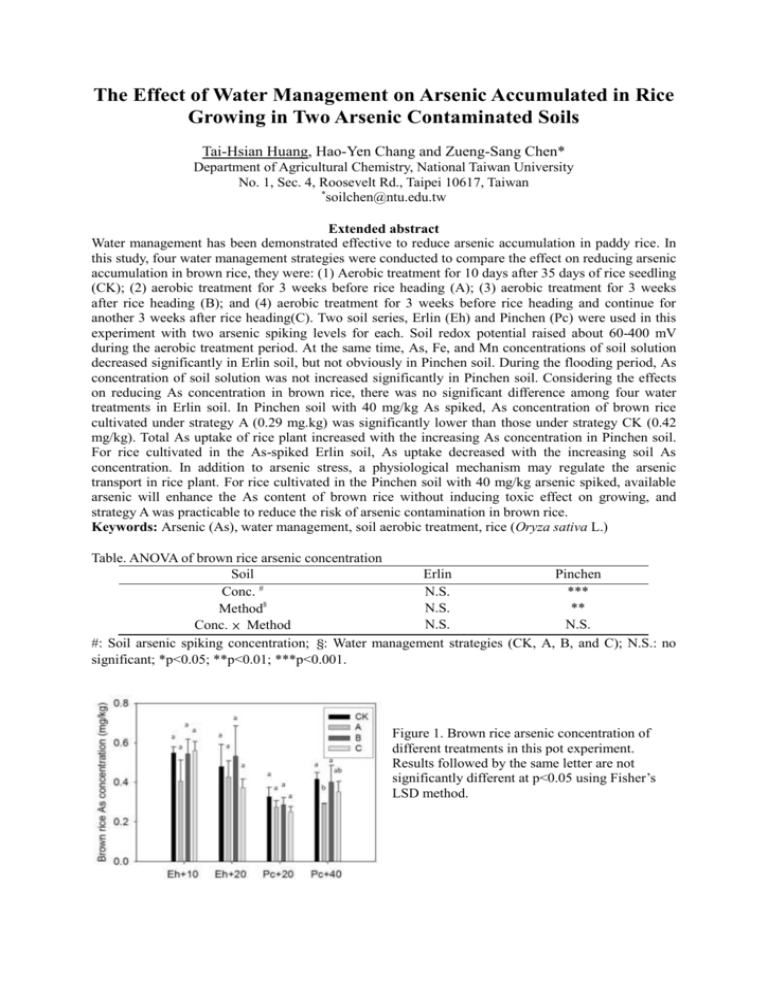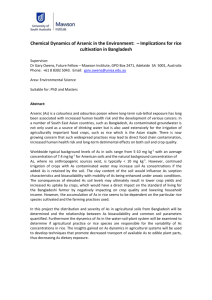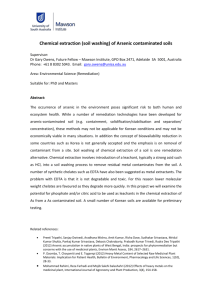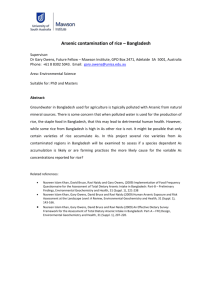The Effect of Water Management on Arsenic Accumulated in Rice
advertisement

The Effect of Water Management on Arsenic Accumulated in Rice Growing in Two Arsenic Contaminated Soils Tai-Hsian Huang, Hao-Yen Chang and Zueng-Sang Chen* Department of Agricultural Chemistry, National Taiwan University No. 1, Sec. 4, Roosevelt Rd., Taipei 10617, Taiwan * soilchen@ntu.edu.tw Extended abstract Water management has been demonstrated effective to reduce arsenic accumulation in paddy rice. In this study, four water management strategies were conducted to compare the effect on reducing arsenic accumulation in brown rice, they were: (1) Aerobic treatment for 10 days after 35 days of rice seedling (CK); (2) aerobic treatment for 3 weeks before rice heading (A); (3) aerobic treatment for 3 weeks after rice heading (B); and (4) aerobic treatment for 3 weeks before rice heading and continue for another 3 weeks after rice heading(C). Two soil series, Erlin (Eh) and Pinchen (Pc) were used in this experiment with two arsenic spiking levels for each. Soil redox potential raised about 60-400 mV during the aerobic treatment period. At the same time, As, Fe, and Mn concentrations of soil solution decreased significantly in Erlin soil, but not obviously in Pinchen soil. During the flooding period, As concentration of soil solution was not increased significantly in Pinchen soil. Considering the effects on reducing As concentration in brown rice, there was no significant difference among four water treatments in Erlin soil. In Pinchen soil with 40 mg/kg As spiked, As concentration of brown rice cultivated under strategy A (0.29 mg.kg) was significantly lower than those under strategy CK (0.42 mg/kg). Total As uptake of rice plant increased with the increasing As concentration in Pinchen soil. For rice cultivated in the As-spiked Erlin soil, As uptake decreased with the increasing soil As concentration. In addition to arsenic stress, a physiological mechanism may regulate the arsenic transport in rice plant. For rice cultivated in the Pinchen soil with 40 mg/kg arsenic spiked, available arsenic will enhance the As content of brown rice without inducing toxic effect on growing, and strategy A was practicable to reduce the risk of arsenic contamination in brown rice. Keywords: Arsenic (As), water management, soil aerobic treatment, rice (Oryza sativa L.) Table. ANOVA of brown rice arsenic concentration Soil Erlin Pinchen # Conc. N.S. *** N.S. ** Method§ N.S. N.S. Conc. × Method #: Soil arsenic spiking concentration; §: Water management strategies (CK, A, B, and C); N.S.: no significant; *p<0.05; **p<0.01; ***p<0.001. Figure 1. Brown rice arsenic concentration of different treatments in this pot experiment. Results followed by the same letter are not significantly different at p<0.05 using Fisher’s LSD method.








